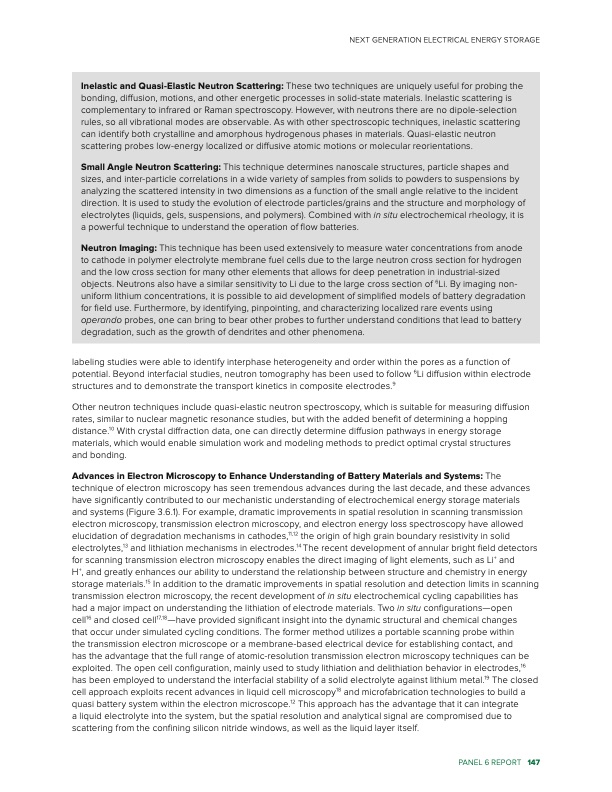
PDF Publication Title:
Text from PDF Page: 153
labeling studies were able to identify interphase heterogeneity and order within the pores as a function of potential. Beyond interfacial studies, neutron tomography has been used to follow 6Li diffusion within electrode structures and to demonstrate the transport kinetics in composite electrodes.9 Other neutron techniques include quasi-elastic neutron spectroscopy, which is suitable for measuring diffusion rates, similar to nuclear magnetic resonance studies, but with the added benefit of determining a hopping distance.10 With crystal diffraction data, one can directly determine diffusion pathways in energy storage materials, which would enable simulation work and modeling methods to predict optimal crystal structures and bonding. Advances in Electron Microscopy to Enhance Understanding of Battery Materials and Systems: The technique of electron microscopy has seen tremendous advances during the last decade, and these advances have significantly contributed to our mechanistic understanding of electrochemical energy storage materials and systems (Figure 3.6.1). For example, dramatic improvements in spatial resolution in scanning transmission electron microscopy, transmission electron microscopy, and electron energy loss spectroscopy have allowed elucidation of degradation mechanisms in cathodes,11,12 the origin of high grain boundary resistivity in solid electrolytes,13 and lithiation mechanisms in electrodes.14 The recent development of annular bright field detectors for scanning transmission electron microscopy enables the direct imaging of light elements, such as Li+ and H+, and greatly enhances our ability to understand the relationship between structure and chemistry in energy storage materials.15 In addition to the dramatic improvements in spatial resolution and detection limits in scanning transmission electron microscopy, the recent development of in situ electrochemical cycling capabilities has had a major impact on understanding the lithiation of electrode materials. Two in situ configurations—open cell16 and closed cell17,18—have provided significant insight into the dynamic structural and chemical changes that occur under simulated cycling conditions. The former method utilizes a portable scanning probe within the transmission electron microscope or a membrane-based electrical device for establishing contact, and has the advantage that the full range of atomic-resolution transmission electron microscopy techniques can be exploited. The open cell configuration, mainly used to study lithiation and delithiation behavior in electrodes,16 has been employed to understand the interfacial stability of a solid electrolyte against lithium metal.19 The closed cell approach exploits recent advances in liquid cell microscopy18 and microfabrication technologies to build a quasi battery system within the electron microscope.12 This approach has the advantage that it can integrate a liquid electrolyte into the system, but the spatial resolution and analytical signal are compromised due to scattering from the confining silicon nitride windows, as well as the liquid layer itself. NEXT GENERATION ELECTRICAL ENERGY STORAGE Inelastic and Quasi-Elastic Neutron Scattering: These two techniques are uniquely useful for probing the bonding, diffusion, motions, and other energetic processes in solid-state materials. Inelastic scattering is complementary to infrared or Raman spectroscopy. However, with neutrons there are no dipole-selection rules, so all vibrational modes are observable. As with other spectroscopic techniques, inelastic scattering can identify both crystalline and amorphous hydrogenous phases in materials. Quasi-elastic neutron scattering probes low-energy localized or diffusive atomic motions or molecular reorientations. Small Angle Neutron Scattering: This technique determines nanoscale structures, particle shapes and sizes, and inter-particle correlations in a wide variety of samples from solids to powders to suspensions by analyzing the scattered intensity in two dimensions as a function of the small angle relative to the incident direction. It is used to study the evolution of electrode particles/grains and the structure and morphology of electrolytes (liquids, gels, suspensions, and polymers). Combined with in situ electrochemical rheology, it is a powerful technique to understand the operation of flow batteries. Neutron Imaging: This technique has been used extensively to measure water concentrations from anode to cathode in polymer electrolyte membrane fuel cells due to the large neutron cross section for hydrogen and the low cross section for many other elements that allows for deep penetration in industrial-sized objects. Neutrons also have a similar sensitivity to Li due to the large cross section of 6Li. By imaging non- uniform lithium concentrations, it is possible to aid development of simplified models of battery degradation for field use. Furthermore, by identifying, pinpointing, and characterizing localized rare events using operando probes, one can bring to bear other probes to further understand conditions that lead to battery degradation, such as the growth of dendrites and other phenomena. PANEL 6 REPORT 147PDF Image | Next Generation Electrical Energy Storage

PDF Search Title:
Next Generation Electrical Energy StorageOriginal File Name Searched:
BRN-NGEES_rpt-low-res.pdfDIY PDF Search: Google It | Yahoo | Bing
Sulfur Deposition on Carbon Nanofibers using Supercritical CO2 Sulfur Deposition on Carbon Nanofibers using Supercritical CO2. Gamma sulfur also known as mother of pearl sulfur and nacreous sulfur... More Info
CO2 Organic Rankine Cycle Experimenter Platform The supercritical CO2 phase change system is both a heat pump and organic rankine cycle which can be used for those purposes and as a supercritical extractor for advanced subcritical and supercritical extraction technology. Uses include producing nanoparticles, precious metal CO2 extraction, lithium battery recycling, and other applications... More Info
| CONTACT TEL: 608-238-6001 Email: greg@infinityturbine.com | RSS | AMP |